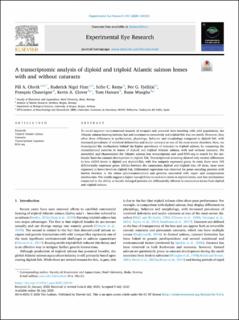| dc.contributor.author | Olsvik, Pål Asgeir | |
| dc.contributor.author | Finn, Roderick Nigel | |
| dc.contributor.author | Remø, Sofie C. | |
| dc.contributor.author | Fjelldal, Per Gunnar | |
| dc.contributor.author | Chauvigné, Francois | |
| dc.contributor.author | Glover, Kevin | |
| dc.contributor.author | Hansen, Tom Johnny | |
| dc.contributor.author | Waagbø, Rune | |
| dc.date.accessioned | 2021-02-18T14:00:09Z | |
| dc.date.available | 2021-02-18T14:00:09Z | |
| dc.date.created | 2020-11-11T15:20:53Z | |
| dc.date.issued | 2020 | |
| dc.identifier.citation | Olsvik, P. A., Finn, R. N., Remø, S. C., Fjelldal, P. G., Chauvigné, F., Glover, K. A., Hansen, T. & Waagbø, R. (2020). A transcriptomic analysis of diploid and triploid Atlantic salmon lenses with and without cataracts. Experimental Eye Research, 199: 108150. doi: | en_US |
| dc.identifier.issn | 1096-0007 | |
| dc.identifier.uri | https://hdl.handle.net/11250/2728998 | |
| dc.description.abstract | To avoid negative environmental impacts of escapees and potential inter-breeding with wild populations, the Atlantic salmon farming industry has and continues to extensively test triploid fish that are sterile. However, they often show differences in performance, physiology, behavior and morphology compared to diploid fish, with increased prevalence of vertebral deformities and ocular cataracts as two of the most severe disorders. Here, we investigated the mechanisms behind the higher prevalence of cataracts in triploid salmon, by comparing the transcriptional patterns in lenses of diploid and triploid Atlantic salmon, with and without cataracts. We assembled and characterized the Atlantic salmon lens transcriptome and used RNA-seq to search for the molecular basis for cataract development in triploid fish. Transcriptional screening showed only modest differences in lens mRNA levels in diploid and triploid fish, with few uniquely expressed genes. In total, there were 165 differentially expressed genes (DEGs) between the cataractous diploid and triploid lens. Of these, most were expressed at lower levels in triploid fish. Differential expression was observed for genes encoding proteins with known function in the retina (phototransduction) and proteins associated with repair and compensation mechanisms. The results suggest a higher susceptibility to oxidative stress in triploid lenses, and that mechanisms connected to the ability to handle damaged proteins are differentially affected in cataractous lenses from diploid and triploid salmon. | en_US |
| dc.language.iso | eng | en_US |
| dc.publisher | Elsevier | en_US |
| dc.rights | Navngivelse 4.0 Internasjonal | * |
| dc.rights.uri | http://creativecommons.org/licenses/by/4.0/deed.no | * |
| dc.title | A transcriptomic analysis of diploid and triploid Atlantic salmon lenses with and without cataracts | en_US |
| dc.type | Peer reviewed | en_US |
| dc.type | Journal article | en_US |
| dc.description.version | publishedVersion | en_US |
| dc.rights.holder | © 2020 The Author(s) | en_US |
| dc.subject.nsi | VDP::Landbruks- og Fiskerifag: 900::Fiskerifag: 920 | en_US |
| dc.subject.nsi | VDP::Landbruks- og Fiskerifag: 900::Fiskerifag: 920::Akvakultur: 922 | en_US |
| dc.subject.nsi | VDP::Matematikk og Naturvitenskap: 400::Basale biofag: 470 | en_US |
| dc.source.pagenumber | 14 | en_US |
| dc.source.volume | 199 | en_US |
| dc.source.journal | Experimental Eye Research | en_US |
| dc.identifier.doi | 10.1016/j.exer.2020.108150 | |
| dc.identifier.cristin | 1847035 | |
| dc.relation.project | Norges forskningsråd: 224816 | en_US |
| dc.description.localcode | Unit Licence Agreement | en_US |
| dc.source.articlenumber | 108150 | en_US |

